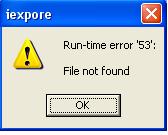How To Resolve mfc71.dll Errors
Mfc71.dll error messages are extremely annoying and common on the Windows system. These errors are caused by a series of issues that either corrupt or make the mfc71.dll file damaged / misplaced. Fortunately, it’s actually quite easy to resolve these errors and this tutorial is going to show you exactly what you need to do.
What Is Mfc71.dll?
Mfc71.dll is a “Dynamic Link Library” file that stores Microsoft Foundation Class (MFC) functions. It’s used whenever a program uses the standard “MFC” functions that are coded into Microsoft Visual Studio.
Unfortunately, this file is used so much that it’s prone to many different errors and causes many Windows PCs to show a variety of messages which prevent you using programs and Windows features. Here are some of the error messages you are most likely to see from this file:
- mfc71.dll is missing
- mfc71.dll is not found
- The application failed to start because mfc71.dll is missing or unreadable
To fix this error, there are several vital steps that need to be taken.
Causes Of The Mfc71.dll Error
The mfc71.dll errors are mostly caused by the corruption, misplacement or removal of this file from your system. Some of the most common causes of this error include a corrupt registry, outdated Windows files, virus infections and the file being misplaced on your system.
How To Fix The Mfc71.dll Error
Step 1 – Put A Fresh Version Of Mfc71.dll Onto Your PC
1) Download this version of mfc71.dll
2) Unzip the file and palce it in the “C:\Windows\System32” folder
3) Click Start > Run > type “cmd” into the run box
4) On the black cmd screen, type “regsvr mfc71.dll”
5) Hit enter
6) Upon success, exit the CMD screen & restart Windows
This will basically place the missing DLL file onto your system and will also register it for use inside your system. For most people, this will work to fix the error that you’re seeing. However, if the error does not disappear, you should try moving onto step 2.
Step 2 – Reinstall Applications Showing The Error
If you’re receiving the error when you load up certain applications, it suggests that you might have a series of damaged program files / settings which are cuasing the program to show this particular error. To fix this, you need to first uninstall the affected program(s) and then install a fresh copy of the program to replace all the old files and settings that could have been damaged. To do this, click on Start > Control Panel > Add /Remove Programs and then find the program that’s causing the issues. Click the “uninstall” button next to it, which will uninstall the program from your PC. After that, it’s just a case of reinstalling the program from the CD or the Internet to replace all the damaged files it might have.
If this does not resolve the error, then you should move on to Step 3…
Step 3 – Update Windows
Microsoft are regularly updating their products and if you’re receiving an error with a particular file, it could be down to Windows being outdated. To fix this, you should click on Start > Control Panel > Windows Update. This will laod up the update console which will show you which updates are ready to be installed on your PC. You should try and attain as many updates as you can to ensure that your computer gets all the latest files.
Step 4 – Run Antivirus Scans
– Download This Antivirus Program
Antivirus programs are software tools which scan through your PC and remove any of the viruses or malware infections that are on your system. It’s often the case that viruses will infect various DLL files on your computer and then cause them to be unreadable to your PC. To ensure this is not happening on your computer, you should try using an antivirus program to scan through your system and remove any of the infections that cause all these errors. You can download our recommended antivirus program from the link above, but there are a large variety of programs available.
Step 5 – Clean The Registry
– Download This Registry Cleaner
The ‘registry’ is a big database inside Windows which keeps a large list of references for the DLL files on your system. This central database is where Windows keeps a list of the DLL file locations for your computer, and is where your system looks each time it wants to use a dll file such as mfc71.dll. Unfortunately, it’s prone to becoming damaged and corrupted and is constantly being unable to read the files and references that it needs to open the files that it wants. This is a major problem that causes a lot of damage to many different parts of your system. Running a registry scan will remove all the damaged references inside the registry, allowing it to run as quickly and smoothly as possible.


